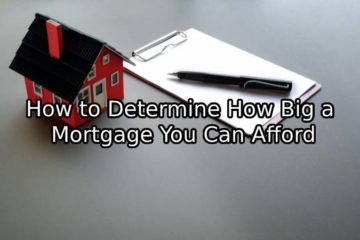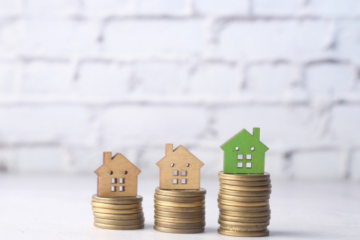A mortgage is a loan that a prospective property owner uses to cover the purchase price of real estate property. Mortgages make it possible for you to buy a home or other real estate property without having to pay the entire purchase price of the property with your own savings.
Over time, you pay back the original amount of the mortgage, called the principal, plus interest. A mortgage’s interest rate is the percentage of the principal that the borrower pays the lender each year in interest. This guide covers the three main types of mortgages:
- Fixed-rate mortgages: Mortgages with interest rates that don’t change over time
- Adjustable-rate mortgages (ARMs): Mortgages with interest rates that change periodically
- Government-issued mortgages: Mortgages financed and offered by the government to qualified borrowers
Table of Contents
How Mortgages Work
The mortgage process involves two main steps: getting a mortgage loan and then paying off that loan. The later sections of this guide cover the entire process in detail.
Getting a Mortgage Loan
If you are a prospective property owner, also called a buyer or borrower, you apply for a mortgage loan from a lender—a bank or other financial institution that specializes in mortgage loans. Most lenders require you to make a down payment, a lump-sum cash payment usually equal to 20% of the property’s purchase price. The principal covers the remainder of the purchase price. For example, if a home costs $200,000 and you pay a 20% down payment ($40,000), the principal is $160,000.
Paying Off a Mortgage
Once you get a mortgage, you repay the principal plus interest in monthly mortgage payments over a set period of time, called a term (usually 15 or 30 years). The 30-year fixed-rate mortgage is the most popular type of mortgage.
The Contents of a Typical Mortgage Payment
Most mortgage payments contain the following:
- Principal: You pay back some amount of the original loan balance in each payment.
- Interest: You pay some amount of interest on the loan in each payment.
- Property tax: All homeowners pay property tax levied by their local government. The exact amount varies based on the property’s location. Most lenders let you bundle prorated property tax payments into monthly mortgage payments for convenience.
- Private mortgage insurance (PMI): If you make a down payment that’s less than 20% of the property’s purchase price, you must pay for PMI, which protects the lender if you fail to make payments or abandons the property.
- Fees: Most lenders charge annual account maintenance fees that get bundled into each mortgage payment. The specific amount of these fees varies according to the terms of the loan.
The Amortization of a Fixed-Rate Mortgage
The amortization of a mortgage is the schedule at which you pay off the loan’s principal plus interest over time. Lenders set up mortgages so that, in the early years of a mortgage, payments are made up of mostly interest and just a bit of principal. Gradually, over the life of the mortgage, the mix shifts the other way: later payments are made of mostly principal and just a bit of interest.
A 30-year fixed mortgage with an interest rate of 6% and a principal of $200,000 would require you to make 359 monthly payments of $1,199.10, plus one final payment of $1,200.16. The table below shows the amount of principal and interest paid in each monthly mortgage payment after certain intervals of time, as well as the effect that those payments have on the remaining balance of the loan.
|
Payment No.
|
Interest
|
Principal
|
Balance
|
|||
|
1
|
$1,000.00
|
$199.10
|
$199,800.90
|
|||
|
12 (1 year)
|
$988.77
|
$210.33
|
$197,543.99
|
|||
|
60 (5 years)
|
$931.88
|
$267.22
|
$186,108.80
|
|||
|
120 (10 years)
|
$838.66
|
$360.44
|
$167,371.60
|
|||
|
240 (20 years)
|
$543.32
|
$655.78
|
$108,007.66
|
|||
|
360 (30 years)
|
$6.00
|
$1,194.16
|
$0.00
|
There are a few key points to take away from this table:
- The time required to pay off the principal: Favoring interest over principal means it takes a long time to pay down the principal. In this example, it takes more than 20 years to reduce the principal balance only by half.
- The amount that you pay in interest: Over this loan’s 30-year term, you would pay $431,676.00 in interest, more than double the amount of the principal. Most borrowers pay similar amounts in interest (relative to principal), unless they choose to pay down more of the principal sooner. Most loans allow you to pay down the principal at any time.
By paying even a small amount in extra principal each month, you can pay off a loan years early and save enormous amounts of money. If, in the previous example, the you made additional principal payments of only $100 per month, the loan would be paid off in less than 25 years, and you would save $49,000 in interest charges.
Mortgage Interest Rates
Lenders determine an appropriate interest rate to charge for each mortgage loan they issue based on three factors: the riskiness of the loan, the size of the loan, and current interest rates:
- Riskiness of the loan: The riskiness of a loan depends on your financial stability and reputation as a borrower. Your financial stability is based on your income, savings, and other factors, such as whether you are self-employed. Your financial reputation is reflected in your credit score, a numerical representation of your reliability as a borrower. Borrowers who pay off their debts reliably and in full have high credit scores (greater than 700 or so). A mix of financial stability and a high credit score will secure the lowest interest rates from lenders.
- Size of the loan: Mortgage loans that total more than $417,000 (as of 2007) are called jumbo loans; loans below this amount are called conforming loans. (Two exceptions: in Alaska and Hawaii, jumbo loans are $625,500 and up.) Typically, interest rates on jumbo loans are higher than those on conforming loans.
- Current interest rates: The U.S. government sets various interest rates, including mortgage interest rates, based on economic factors. Over the past 25 years, rates have ranged from roughly 5% to 18%.
Why Get a Mortgage?
Mortgages make home ownership possible for people who otherwise could not afford the entire purchase price of a home. (In 2006, the average single-family home cost $307,000; the average home of any type cost $230,000.) There are two other important reasons to get a mortgage:
- Avoid tying up your money in your home: Money spent on a home can’t be “withdrawn” until you sell the home. With a mortgage, you’re responsible for paying the down payment and making monthly payments, but you don’t have to sink hundreds of thousands of dollars into your home. Instead, you can use that money to pay your monthly mortgage payment and all of your other bills. You can also invest it in investments that you expect to perform better than real estate over time, such as mutual funds or stocks.
- Take advantage of tax benefits: To encourage people to become homeowners, the government allows most homeowners to deduct from their income taxes 100% of the mortgage interest and property tax they pay annually. If you’re in the 28% federal income tax bracket and have a mortgage payment that currently includes $1,000 in interest and property tax, after tax deductions you’ll pay only 72% of that $1,000, or $720. These tax benefits can amount to thousands of dollars in savings each year. On the contrary, if you rent, you can’t take any tax deductions related to rent payments. Likewise, if you buy property but don’t use a mortgage, you can deduct only your property tax payments.


